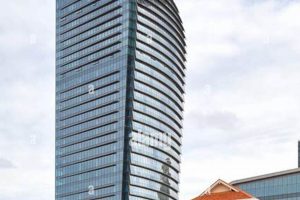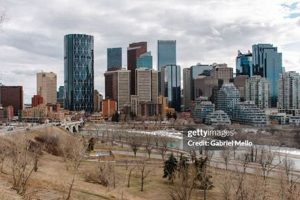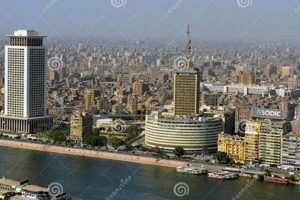Skyscrapers in India are a relatively recent phenomenon, with the first high-rise building being constructed in Mumbai in the 1960s. However, in recent years, there has been a boom in skyscraper construction in India, with many new skyscrapers being built in major cities such as Mumbai, Delhi, and Bangalore.
There are several reasons for this boom in skyscraper construction. One reason is the growing demand for office space in India’s major cities. As India’s economy continues to grow, more and more businesses are setting up offices in these cities. This has led to a corresponding increase in the demand for office space, which has in turn led to the construction of more skyscrapers.
Another reason for the boom in skyscraper construction is the increasing availability of land in India’s major cities. In the past, land was scarce in these cities, which made it difficult to build skyscrapers. However, in recent years, the government has released more land for development, which has made it possible to build more skyscrapers.
The construction of skyscrapers in India has had a number of positive impacts. One impact has been the creation of new jobs. The construction of a single skyscraper can create hundreds of jobs, both directly and indirectly. Additionally, the presence of skyscrapers can make a city more attractive to businesses and tourists, which can lead to further economic development.
1. Height
Height is a defining characteristic of skyscrapers, and India’s skyscrapers are no exception. The height of a skyscraper can have a significant impact on its design, construction, and use. Here are four key aspects of height in relation to India’s skyscrapers:
- Structural Considerations
The height of a skyscraper can have a significant impact on its structural design. Taller buildings require more robust structural systems to withstand wind loads and seismic activity. India’s skyscrapers often incorporate innovative structural engineering techniques to achieve great heights.
- Vertical Transportation
The height of a skyscraper also affects the design of its vertical transportation systems. Taller buildings require more elevators and other means of vertical transportation to move people and goods efficiently. India’s skyscrapers often feature state-of-the-art vertical transportation systems to ensure convenient and efficient movement within the building.
- Views and Amenitie
The height of a skyscraper can offer stunning views of the surrounding cityscape. Taller buildings can also accommodate more amenities, such as rooftop gardens, observation decks, and fitness centers. India’s skyscrapers often feature impressive views and amenities that enhance the experience of occupants and visitors.
- Urban Planning
The height of a skyscraper can also impact urban planning. Taller buildings can cast shadows on neighboring buildings and streets, and they can also affect wind patterns. India’s skyscrapers are often carefully planned to minimize these impacts and ensure compatibility with the surrounding urban environment.
In conclusion, height is a crucial aspect of India’s skyscrapers. It influences the structural design, vertical transportation systems, views and amenities, and urban planning considerations. India’s skyscrapers are designed to achieve great heights while ensuring structural integrity, efficient movement, and a positive impact on the surrounding environment.
2. Architecture
Architecture plays a pivotal role in shaping the identity and functionality of India’s skyscrapers. The architectural design of these towering structures reflects a fusion of global trends, cultural influences, and innovative engineering solutions. Here are four key architectural aspects of India’s skyscrapers:
- Facade Design
The facade of a skyscraper is its, and it can have a significant impact on the building’s overall appearance and energy efficiency. India’s skyscrapers often feature intricate facade designs that incorporate traditional motifs, modern materials, and sustainable elements. For example, the Lodha Bellissimo in Mumbai features a facade inspired by traditional Indian jali screens, while the World One in Mumbai utilizes a double-skin facade to reduce heat gain.
- Structural Systems
The structural system of a skyscraper is responsible for ensuring its stability and integrity. India’s skyscrapers employ a variety of structural systems, including reinforced concrete frames, steel frames, and composite structures. The choice of structural system depends on factors such as the height of the building, the seismic zone, and the availability of materials. For example, the Imperial Tower II in Mumbai uses a reinforced concrete frame, while the DLF Cyber City Tower in Gurgaon utilizes a steel frame.
- Sustainability Features
Sustainability is an increasingly important consideration in the design of India’s skyscrapers. Many of these buildings incorporate sustainable features such as rainwater harvesting systems, solar panels, and energy-efficient lighting. For example, the C2C (Commercial to Core) building in Hyderabad is designed to achieve LEED Platinum certification, and it features a rainwater harvesting system that can collect up to 10 million liters of rainwater annually.
- Cultural Influences
India’s rich cultural heritage is often reflected in the architectural design of its skyscrapers. Many of these buildings incorporate traditional motifs, patterns, and materials into their design. For example, the Jio World Centre in Mumbai features a facade inspired by traditional Indian textiles, while the Phoenix Palladium in Mumbai incorporates traditional Indian motifs into its interior design.
In conclusion, architecture plays a crucial role in shaping the identity and functionality of India’s skyscrapers. The architectural design of these towering structures reflects a fusion of global trends, cultural influences, and innovative engineering solutions. As India’s cities continue to grow and evolve, its skyscrapers will continue to serve as landmarks that reflect the country’s architectural prowess and cultural heritage.
3. Sustainability
Sustainability has become an increasingly important consideration in the design and construction of skyscrapers around the world, and India is no exception. India’s skyscrapers are incorporating a range of sustainable features to reduce their environmental impact and improve their overall performance.
- Energy Efficiency
On
e of the key areas of focus for sustainability in India’s skyscrapers is energy efficiency. Many of these buildings are using energy-efficient lighting systems, appliances, and HVAC systems to reduce their energy consumption. For example, the C2C (Commercial to Core) building in Hyderabad is designed to achieve LEED Platinum certification, and it features a rainwater harvesting system that can collect up to 10 million liters of rainwater annually. - Water Conservation
Water conservation is another important aspect of sustainability in India’s skyscrapers. Many of these buildings are using rainwater harvesting systems, low-flow plumbing fixtures, and drought-tolerant landscaping to reduce their water consumption. For example, the World One tower in Mumbai has a rainwater harvesting system that can collect up to 10 million liters of rainwater annually, which is used for flushing toilets and watering the building’s landscaping.
- Waste Reduction
Waste reduction is also a key focus for sustainability in India’s skyscrapers. Many of these buildings are using recycling programs, composting systems, and low-VOC (volatile organic compound) materials to reduce their waste output. For example, the Lodha Bellissimo in Mumbai has a waste management system that diverts over 80% of the building’s waste from landfills.
- Indoor Environmental Quality
Indoor environmental quality is also important for sustainability in India’s skyscrapers. Many of these buildings are using natural ventilation, daylighting, and low-VOC materials to improve the indoor air quality and create a more comfortable and healthy environment for occupants. For example, the C2C building in Hyderabad has a double-skin facade that allows for natural ventilation and daylighting, and it also uses low-VOC materials to improve the indoor air quality.
By incorporating these and other sustainable features, India’s skyscrapers are reducing their environmental impact and improving their overall performance. As India’s cities continue to grow and evolve, its skyscrapers will continue to serve as landmarks that reflect the country’s commitment to sustainability.
4. Location
Location is a crucial factor in the development and success of India’s skyscrapers. The choice of location can impact various aspects of a skyscraper, from its design and construction to its occupancy and economic viability.
- Central Business Districts
Many of India’s skyscrapers are located in central business districts (CBDs) of major cities such as Mumbai, Delhi, and Bengaluru. CBDs offer several advantages for skyscrapers, including proximity to key businesses, financial institutions, and government offices. For example, the Bandra Kurla Complex in Mumbai is a major CBD that houses several of India’s tallest skyscrapers, including the Imperial Tower II and the One BKC.
- Transportation Hubs
Another important location factor for India’s skyscrapers is proximity to transportation hubs such as airports, railway stations, and metro lines. This is especially important for skyscrapers that cater to international businesses and travelers. For example, the World Trade Center in Mumbai is located near the Chhatrapati Shivaji Maharaj International Airport, making it convenient for business travelers.
- Land Availability
The availability of land is also a key consideration in the location of India’s skyscrapers. Skyscrapers require large parcels of land, which can be scarce in densely populated cities. In recent years, there has been a trend towards developing skyscrapers in suburban areas where land is more readily available. For example, the Lodha Bellissimo in Mumbai is located in the suburban area of Mahalaxmi.
- Urban Planning
Urban planning regulations also play a role in the location of India’s skyscrapers. Local governments often have height restrictions and other regulations in place to ensure that skyscrapers do not negatively impact the surrounding urban environment. For example, the Mumbai Municipal Corporation has height restrictions in place to prevent skyscrapers from blocking sunlight and air circulation in neighboring buildings.
In conclusion, location is a critical factor in the development and success of India’s skyscrapers. Skyscrapers are often located in central business districts, near transportation hubs, and in areas with sufficient land availability. Urban planning regulations also play a role in determining the location of skyscrapers. By considering all of these factors, developers can choose the best possible location for their skyscraper projects.
5. Tenants
Tenants play a crucial role in the success and viability of India’s skyscrapers. The type and quality of tenants can impact various aspects of a skyscraper, including its rental income, occupancy rates, and overall reputation.
- Commercial Tenants
Commercial tenants are the most common type of tenants in India’s skyscrapers. These tenants include businesses, financial institutions, and government agencies. Commercial tenants typically lease large amounts of space in skyscrapers, and they often sign long-term leases. This provides a stable source of income for skyscraper owners and helps to ensure the building’s long-term success.
- Residential Tenants
Residential tenants are also becoming increasingly common in India’s skyscrapers. These tenants include individuals and families who choose to live in luxury apartments or penthouses. Residential tenants typically lease smaller amounts of space in skyscrapers, and they often sign shorter-term leases. However, they can still contribute significantly to a skyscraper’s overall revenue.
- Mixed-Use Tenants
Mixed-use skyscrapers are becoming increasingly popular in India. These skyscrapers combine commercial and residential space, as well as other uses such as retail, hospitality, and entertainment. Mixed-use skyscrapers can attract a wider range of tenants, and they can help to create a more vibrant and dynamic urban environment.
- International Tenants
India’s skyscrapers are also attracting an increasing number of international tenants. These tenants include multinational corporations, foreign banks, and wealthy individuals. International tenants are often willing to pay higher rents for space in India’s skyscrapers, and they can help to boost the building’s prestige and reputation.
The type and quality of tenants in a skyscraper can have a significant impact on its overall success. Skyscrapers with a high concentration of blue-chip tenants are more likely to be successful in the long term. These tenants are typically more reliable, they pay their rent on time, and they are less likely to vacate the building. As a result, skyscrapers with a high concentration of blue-chip tenants are more attractive to investors and lenders.
6. Investment
Investment plays a crucial role in the development and construction of India’s skyscrapers. Skyscrapers are capital-intensive projects that req
uire significant upfront investment. This investment can come from a variety of sources, including private equity, debt financing, and government subsidies.
One of the key challenges in financing a skyscraper project is securing long-term financing. Skyscrapers have long construction timelines, and they can take several years to complete. This means that developers need to secure financing that will cover the entire construction period, as well as the initial operating costs of the building. In India, there are a number of financial institutions that provide long-term financing for skyscraper projects. These institutions typically require developers to have a strong track record and a solid financial plan in place.
In addition to long-term financing, developers may also need to secure short-term financing to cover the costs of land acquisition and construction. Short-term financing can be obtained from banks and other financial institutions. Developers may also use mezzanine financing, which is a type of hybrid financing that combines elements of both debt and equity. Mezzanine financing can be a more expensive option, but it can also provide developers with more flexibility.
The investment in India’s skyscrapers is a significant driver of economic growth. Skyscrapers create jobs, boost the real estate market, and attract foreign investment. In addition, skyscrapers can help to improve the quality of life in Indian cities by providing much-needed office space, residential units, and retail space.
7. Future
The future of India’s skyscrapers is bright. The demand for office space, residential units, and retail space in India’s major cities is expected to continue to grow in the coming years, which will lead to the construction of even more skyscrapers. These buildings will continue to play an important role in the country’s economic growth and development.
One of the key trends that is expected to shape the future of India’s skyscrapers is the increasing use of sustainable design and construction practices. Skyscrapers are energy-intensive buildings, and there is a growing recognition of the need to reduce their environmental impact. As a result, many new skyscrapers in India are being designed to achieve LEED certification or other green building standards. These buildings incorporate a variety of sustainable features, such as energy-efficient lighting and appliances, water-saving fixtures, and recycled materials.
Another key trend that is expected to shape the future of India’s skyscrapers is the increasing use of mixed-use developments. Mixed-use skyscrapers combine commercial, residential, and retail space in a single building. This type of development can help to create more vibrant and sustainable urban environments. Mixed-use skyscrapers can also be more efficient to build and operate than traditional skyscrapers that are dedicated to a single use.
The future of India’s skyscrapers is full of potential. By incorporating sustainable design and construction practices and by embracing mixed-use developments, India’s skyscrapers can continue to play a major role in the country’s economic growth and development while also minimizing their environmental impact.
FAQs on India Skyscrapers
India’s skyscrapers are a testament to the country’s growing economic power and architectural prowess. These towering structures offer a variety of benefits, but they also raise some concerns. Here are answers to some frequently asked questions about India’s skyscrapers:
Question 1: What are the benefits of building skyscrapers in India?
Skyscrapers offer a number of benefits, including:
- Increased office space: Skyscrapers can provide much-needed office space in India’s major cities, where land is scarce.
- Improved energy efficiency: Skyscrapers can be designed to be energy-efficient, reducing operating costs and environmental impact.
- Enhanced aesthetics: Skyscrapers can add to the beauty and skyline of a city.
- Increased tax revenue: Skyscrapers can generate significant tax revenue for local governments.
Question 2: What are the concerns about building skyscrapers in India?
Some concerns about building skyscrapers in India include:
- High construction costs: Skyscrapers are expensive to build, and this cost can be passed on to tenants in the form of higher rents.
- Increased traffic congestion: Skyscrapers can attract a lot of traffic, which can lead to congestion and pollution.
- Strain on infrastructure: Skyscrapers can put a strain on infrastructure, such as water and electricity supply.
- Negative impact on the environment: Skyscrapers can have a negative impact on the environment, such as by blocking sunlight and casting shadows.
Question 3: How are skyscrapers being built in India?
Skyscrapers in India are being built using a variety of methods, including:
- Steel frame construction: This is the most common method of skyscraper construction in India. Steel frames are strong and lightweight, and they can be used to build skyscrapers of great heights.
- Concrete core construction: This method involves building a central concrete core that supports the rest of the building. Concrete core construction is often used for skyscrapers that are over 100 stories tall.
- Mixed-use construction: This method involves building a skyscraper that includes a mix of uses, such as office space, residential units, and retail space. Mixed-use construction can help to create more vibrant and sustainable urban environments.
Question 4: What are the tallest skyscrapers in India?
The tallest skyscrapers in India are:
- Mumbai One Tower (282 meters)
- Imperial Tower II (254 meters)
- Lodha Bellissimo (252 meters)
- World One (250 meters)
- Palais Royale (248 meters)
Question 5: What is the future of skyscrapers in India?
The future of skyscrapers in India is bright. The demand for office space, residential units, and retail space in India’s major cities is expected to continue to grow in the coming years, which will lead to the construction of even more skyscrapers. These buildings will continue to play an important role in the country’s economic growth and development.
Summary: Skyscrapers offer a number of benefits, but they also raise some concerns. By carefully considering the benefits and concerns, and by using sustainable construction methods, India can continue to build skyscrapers that meet the needs of its growing population and economy.
Transition to the next article section: India’s skyscrapers are a symbol of the country’s growing economic power and architectural prowess. These towering structures offer a variety of benefits, but they also raise some concerns. By carefully considering the benefits and concerns, and by using sustainable construction methods, India can continue to build skyscrapers that meet the needs of its growing population and economy.
Tips for Designing and Building India Skyscrapers
Skyscrapers are becoming increasingly common in India’s major cities. These towering structures offer a number of benefits, but they also present some challenges. Here are five tips for designing and building India skyscrapers:
Tip 1: Consider the local context.
Skyscrapers should be designed to complement the local context. This includes taking into account the city’s climate, culture, and architectural heritage. For example, a skyscraper in a hot climate should be desig
ned to minimize heat gain, while a skyscraper in a seismically active area should be designed to withstand earthquakes. Tip 2: Use sustainable design and construction practices.
Skyscrapers can be energy-intensive buildings. Therefore, it is important to use sustainable design and construction practices to reduce their environmental impact. This includes using energy-efficient lighting and appliances, water-saving fixtures, and recycled materials. Tip 3: Incorporate mixed-use developments.
Mixed-use skyscrapers combine commercial, residential, and retail space in a single building. This type of development can help to create more vibrant and sustainable urban environments. Mixed-use skyscrapers can also be more efficient to build and operate than traditional skyscrapers that are dedicated to a single use. Tip 4: Pay attention to the building’s facade.
The facade of a skyscraper is its outer skin. It plays a major role in the building’s overall appearance and energy efficiency. When designing the facade, architects should consider factors such as sunlight, wind, and rain. Tip 5: Get the right team in place.
Building a skyscraper is a complex undertaking. It is important to get the right team in place, including architects, engineers, contractors, and project managers. The team should have experience in designing and building skyscrapers, and they should be committed to delivering a high-quality product.
By following these tips, developers can design and build India skyscrapers that are sustainable, efficient, and beautiful.
Conclusion: India’s skyscrapers are a symbol of the country’s growing economic power and architectural prowess. By carefully considering the local context, using sustainable design and construction practices, incorporating mixed-use developments, paying attention to the building’s facade, and getting the right team in place, developers can build skyscrapers that meet the needs of India’s growing population and economy.
Conclusion
India’s skyscrapers are a testament to the country’s growing economic power and architectural prowess. These towering structures offer a variety of benefits, including increased office space, improved energy efficiency, and enhanced aesthetics. However, it is important to carefully consider the concerns associated with skyscrapers, such as high construction costs, increased traffic congestion, and strain on infrastructure. By using sustainable design and construction practices, and by incorporating mixed-use developments, India can continue to build skyscrapers that meet the needs of its growing population and economy.
Skyscrapers are a symbol of India’s progress and ambition. They are a reminder that anything is possible if we set our minds to it. As India continues to grow and develop, its skyscrapers will continue to reach new heights, both literally and figuratively.







